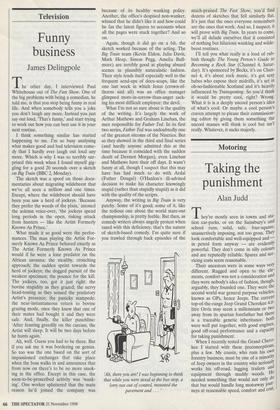Motoring
Taking the punishment
Alan Judd
They're mostly seen in towns and tion car-parks, or on the Sainsbury's school runs, solid, safe, four-square, unassertively imposing, not too gross. They look comfortable and well-equipped and — in petrol form anyway — are evidently powerful. They don't come in silly colours and are reputedly reliable. Spares and ser- vicing costs seem reasonable. sta- and Their ancestors were in some ways very different. Rugged and open to the ele- ments, comfort was not a consideration and they were nobody's idea of fashion, though, arguably, they founded one. They were the second world war general purpose vehicles, known as GPs, hence Jeeps. The current top-of-the-range Jeep Grand Cherokee 4.0- litre Orvis may seem a millennium or two away from its spartan forefather but there is a traceable genetic inheritance: both were well put together, with good engines, good off-road performance and a capacity for taking punishment. When I recently tested the Grand Chero- kee I started with these preconceptions, plus a few. My cousin, who runs his own forestry business, must be one of a minority of Jeep owners in the country who seriously works his off-road, lugging trailers and equipment through muddy woods. fle needed something that would not only do that but would handle long motorway jotir" neys at reasonable speed, comfort and cost, without any diesel knock or clatter. His 4.0- litre Cherokee Limited is five years old and has clocked up 60,000 miles, during which his only repairs — apart from servicing have been the replacement of the battery and the H/T leads. When I've driven it, I've liked the unstressed power (the engine is a venerable cast-iron block of 1960s origin), the high level of equipment (air-condition- ing and cruise control are standard) and the big square bonnet view. I haven't liked the cramped cabin which will not permit a grown man to sit upright in the back and the squidgy, concave front seats that should be known as Back-Ache Specials, especially In conjunction with slightly off-set Make It Worse pedals. In later models, I believe, the seats were improved, while in the Grand Cherokee the cabin is, of course, larger.
As you might expect for £33,520, the Orvis is luxuriously appointed and, after initial doubts, I found the lumbar-support- ed seats comfortable. Headroom was just about OK — after I'd had a haircut — but would be better without a sunroof. The pedals didn't appear to be off-set, the car felt solid on the road and handled well. Although there's inevitably more wobble and roll than in vehicles with lower centres of gravity, it was at an acceptable level and anyway less noticeable than in most of the competition. Sound levels were low, pock- ets and stowage ample, the controls easy to use — though it could benefit from a light switch that remains illuminated in the dark. On a 700-mile round trip that included rough weather in the Yorkshire Dales, the car endeared itself as comfortable, safe and Capable, a good well-engineered product. But life without quibbles would be dull, so it's important to find them. There's a band of darkened glass at the top of the windscreen just at the point where the eye shifts between that and clear glass; gradual shading would be better. At £33,520 you have a right to expect a car to be fully adapted to right-hand drive and not to have a left-hand drive gearbox console that places the handbrake and low ratio selector inconveniently distant for those without simian arms. While it would be quite wrong t0 say that the 174 bhp engine is in any way inadequate for the Grand's heavier body, You are aware that it and the gearbox have to work harder than in the smaller Chero- kee. Acceleration in cruise control is need- lessly abrupt. You can see why the left-hand drive versions of the Grand have 5.2 or 5.9 litre engines (which apparently can't be squeezed into the right-hand drive version). That said, at a steady 70 mph the 4.0-litre engine runs at only 2,000 revs and over 700 miles it averaged a surprising 26-27 mpg. A different matter in town, of course. For a vehicle voted 4X4 of the year by three magazines (one of them twice) since Its introduction in 1996, you would expect off-road performance to be good as well, and so it probably is. 'Probably' because I didn't test it on hills, but I can testify that on heavy waterlogged clay it copes like a hovercraft. It will certainly do all that most drivers are ever likely to ask.
Is there a catch? Well, there's to be a new model next year, powered by a 4.7-litre V8 or 3.1 turbo-diesel and with only 127 parts (mostly clips and fasteners) carried over. Some will prefer to await that model but there are arguments for starting with the present one. First, it's proved itself and you often get good deals on about-to-be- superseded models, with extras thrown in as standard. Second, the already well- equipped Grand is good value, starting as it does at £26,520 (compare with its equiva- lent Discovery). Third, Jeeps hold their prices well and you're likely to get a good trade-in against the new one when it comes. Fourth, it's a buyers' market at the moment and there are some good deals out there which may not be around next year. Finally, it's a car you feel you can trust and it grows on you, rather. Quibbles apart, I could be seriously tempted if I could find a way of not having to pay.



















































































 Previous page
Previous page